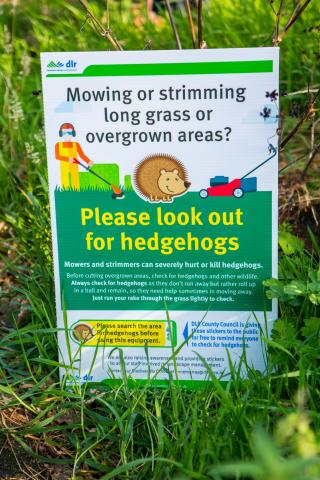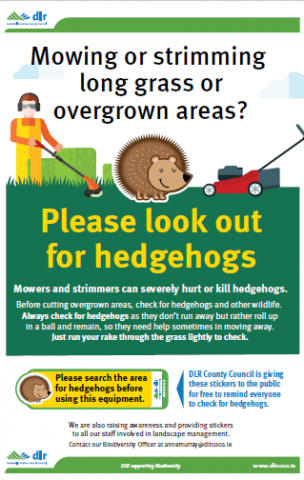Helping our Hedgehogs - Check before you strim or mow
Ireland has one native species of hedgehog, the European Hedgehog. How can you help these wonderful creatures:
- Avoid interfering with hedgehog nests which are often located in hedgerows, compost heaps and leaf litter.
- Avoid the use of slug pellets and pesticides in your garden
- You can offer hedgehogs an overwintering site by providing a pile of hay, leaves or straw under a dry shed or log pile
- Mowing and strimmers can severely hurt or kill hedgehogs. So, before cutting or clearing overgrown areas, check for hedgehogs and other wildlife. Tap the top of vegetation lightly to move hiding wildlife away or run a rake gently through the grass. Check for hedgehogs as they don’t always run away but rather roll up in a ball and remain, so they need help sometimes in moving away.
DLR are giving these stickers away for free to remind everyone to check for hedgehogs and help them. If you would like a sticker for your strimmer or lawnmower just contact our Biodiversity Officer at annemurray@dlrcoco.ie or DLR Parks Admin section.
We are also providing these to all our staff and contractors involved in landscape management.
You can also make a mammal tunnel in your garden to detect and record hedgehogs.
And in the meantime, there is some more information in the Discovering Hedgehogs presentation by the Hedgehog Project Officer, the new Helping Hedgehogs Leaflet and Get Creative for Hedgehogs this Autumn by Wild About Gardens which can be found at the end of this page. You can also check out the Gardening for Biodiversity on our Biodiversity Activities webpage.
Some hedgehog facts – A hedgehog has a tail
Everyone is sure to know what a hedgehog looks like. The hedgehog’s back and sides are covered in long spines. There are no spines on the face, chest, belly, throat and legs which are covered with grey-brown fur. There are up to 7,000 spines on an average adult hedgehog.
What many people do not know is that a hedgehog has a small tail.
1. Where do hedgehogs live?
Hedgehogs like areas with good cover of bushes and hedgerows which provide them with shelter, food and corridors to travel through the county. They are solitary animals and they may have several, temporary nests that they use to rest during the day. Animals are usually most active from April to October, but they can sometimes be seen also during the winter months.
3. Hedgehogs can hibernate
Hedgehogs do tend to hibernate between November and mid-March and may choose the stack of leaves or branches or long grass in your garden. For this reason, if you have to get rid of such material, check it for hedgehogs; a hedgehog may be sheltering or hibernating in it. They like to nest under things (e.g. sheds, hedges and leaves or log piles) and need plenty of dry leaves to build their nest.
2. They are nocturnal
Hedgehogs are nocturnal which means that they sleep in the day and only come out at night.
2. Where did their name come from?
The ‘Hedge’ part of their name comes from where they build their nests hedges, bushes and shrubs. The ‘hog’ part comes from the small snorting/ grunting sound they make which is similar to a pig.
3. Hedgehogs are lactose intolerant
Please do not leave milk out for hedgehogs. Hedgehogs are actually lactose intolerant, so milk should never be left out for them, water is what they drink.
4. Hedgehogs are noisy eaters and their long snout is useful
Hedgehogs have a really long snout to help them hunt. It is even ahead of their mouths as it makes it easier to forage for their staple diet of insects, worms, caterpillars and berries.
5. They don’t use their eyes to hunt
They hunt primarily using they hearing and smell because their eyesight is not very good, although they can see quite well in the dark.
6. They have over up to 7,000 spikes
Hedgehogs have around 5000 to 7000 spines on their back. These can be raised and lowered to respond to threatening situations. Each quill/ spine lasts about a year before dropping out and being replaced.
7. Why do they role up in a ball?
The hedgehog has a vulnerable stomach, which is why it curls up into a spiky ball when predators are around.
8. They are solitary creatures
Hedgehogs venture out on their own after only four to seven weeks of nurturing from their mother. They usually then spend their entire lives alone with the exception of pairing up to mate with another hedgehog.
9. A group is called an array
It is extremely rare that you will see multiple hedgehogs together in one place other than when mating, but if you do it is called an array.
10. Hedgehogs are a gardeners’ friend
Hedgehogs have earned this reputation because of their eating habits. Not only do they enjoy berries and fruit but the staple of their diet is made up from pests that are common in our back gardens such as beetles and caterpillars. This helps preserve the fruit and vegetables you may have growing in your gardens.
11. Little legs can walk far
When hedgehogs are out to forage in the evening, they can travel for up to 2 miles, that’s a long way for those little legs!






